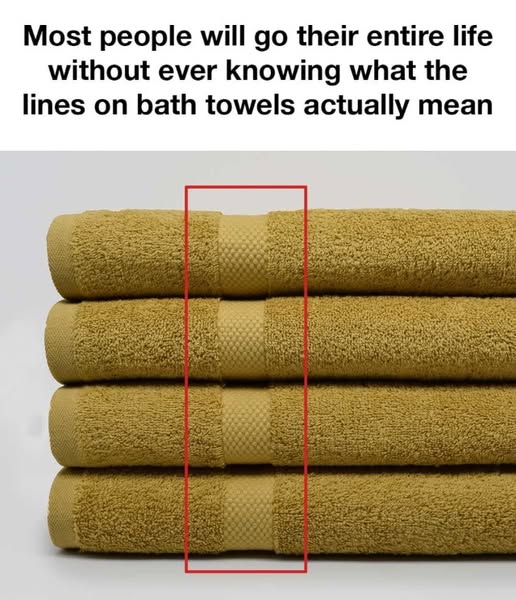
When you grab a towel fresh out of the linen closet, have you ever noticed the subtle lines or bands stitched across it? They’re often slightly different in texture or thickness than the rest of the fabric. Maybe you assumed they were just decorative accents to make the towel look nicer. While they do add a touch of elegance, these mysterious lines actually serve a much more practical purpose — and once you learn it, you’ll never look at your towels the same way again.
It’s More Than Just Decoration
Most of us grew up using towels without giving them a second thought. We dry off, toss them in the laundry, and repeat. But if you take a closer look, you’ll notice that nearly all quality towels — especially bath towels — have those signature woven bands. Manufacturers didn’t just add them for aesthetic reasons.
These textured lines are called dobby borders, and they play a surprisingly important role. Their primary purpose is to prevent the towel from losing its shape over time.
Without the dobby borders, towels are more likely to stretch, distort, and become misshapen after repeated use and wash cycles. Think about how often you’ve seen older towels that look saggy, uneven, or twisted — that’s what the dobby border is designed to prevent.
How Dobby Borders Work
Towels are typically made from cotton loops, which are soft and highly absorbent but not very structurally strong. As you use and wash a towel, the constant pulling, twisting, and wringing can cause those loops to stretch out.
The dobby border, made with a tighter weave and different stitching, acts almost like a stabilizing belt. It reinforces the towel and keeps it from becoming distorted. The border offers a stronger, less flexible section that absorbs some of the tension during use and laundering, allowing the main fabric to stay intact and keep its original shape.
In simpler terms, the lines you see are a built-in feature designed to make your towel last longer and stay looking good.

Why Some Towels Look Worn Out Quickly
Have you ever noticed that cheaper towels, especially the ones without any visible borders or with very thin decorative bands, tend to wear out and lose their shape faster? That’s not a coincidence.
Lower-quality towels often skip the dobby border or use a very basic one, prioritizing cost over durability. Without proper reinforcement, these towels stretch, fray, and lose their plushness after only a few washes.
That’s why investing in towels with well-constructed dobby borders isn’t just about luxury — it’s about getting better value for your money in the long run.
Dobby Borders and Shrinkage
Another hidden advantage of these lines is how they help manage shrinkage. Cotton naturally shrinks when exposed to heat and moisture — in other words, every time you toss your towels into a hot wash or dryer.
The dobby border reduces how much the towel contracts during this process. It keeps the edges firm and minimizes warping, which is why well-made towels retain a nice, rectangular shape even after years of use.
Without these stabilizing bands, you might notice your towels shrinking unevenly, creating weird curves or waves along the edges. Not exactly the polished, spa-like look most of us want in our bathrooms.
They Add a Visual Cue for Folding
There’s also a practical bonus: those bands help you fold towels neatly. If you pay attention next time, you’ll notice that folding along the border lines gives a cleaner, crisper look. Hotels and luxury resorts often rely on these subtle design cues to ensure that towels stack uniformly and look pristine on shelves or carts.
So, if you’ve ever wondered why your towels at home never quite match the sleek, organized vibe of hotel linens, now you know part of the secret.
Not All Dobby Borders Are the Same
It’s important to realize that not all dobby borders are created equal. The thickness, weave pattern, and type of thread used can vary dramatically from one towel to another.
High-end towels often feature thicker, denser dobby borders, which not only provide better durability but also add a sophisticated visual appeal. Some premium towels even incorporate decorative elements into the dobby weave without compromising strength.
Meanwhile, budget towels may have flimsy borders that are more for show than actual function.
When shopping for towels, it’s a smart idea to run your hand across the dobby border and feel its construction. A strong, tightly woven border is a good sign you’re purchasing a towel that will go the distance.
Takeaways: A Small Detail That Makes a Big Difference
The next time you’re in the market for new towels, don’t just focus on color, softness, or price. Take a few moments to inspect the borders. A good dobby border means your towel will:
-
Resist stretching and distortion
-
Maintain its plushness and shape over time
-
Shrink less after repeated washes
-
Look tidier when folded
-
Ultimately last longer, saving you money
It’s amazing how something so simple — a few subtle lines — can have such a huge impact on the quality and longevity of a towel. Now that you know the real purpose behind them, you’ll appreciate your towels even more — and you’ll be a much smarter shopper next time you’re upgrading your linen closet.





